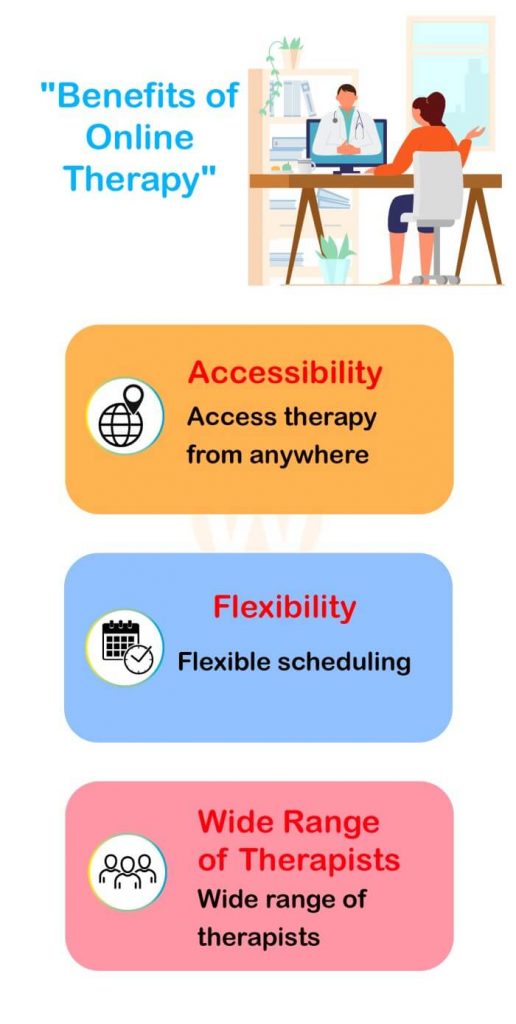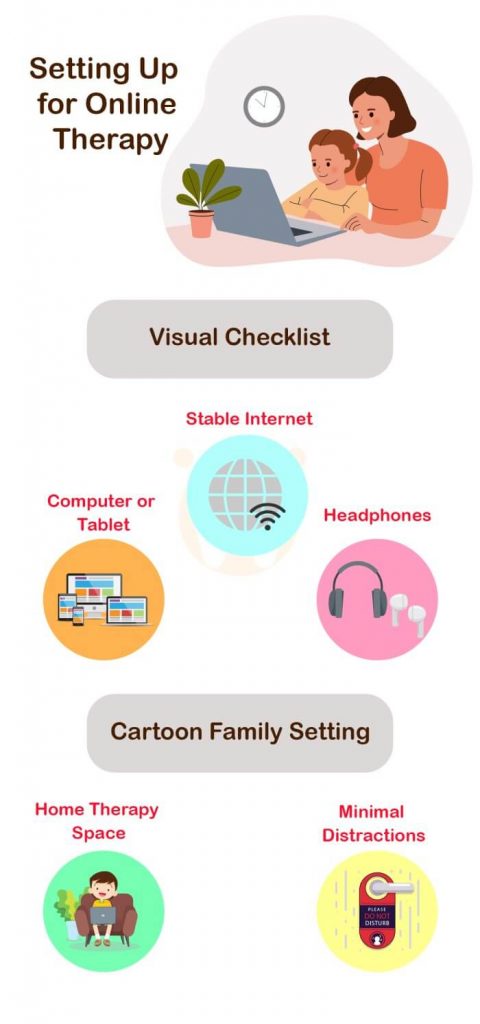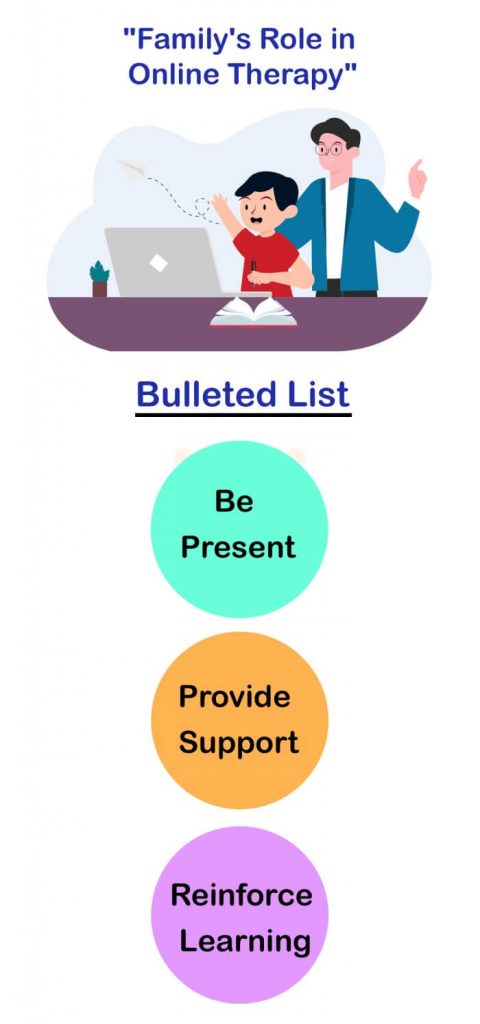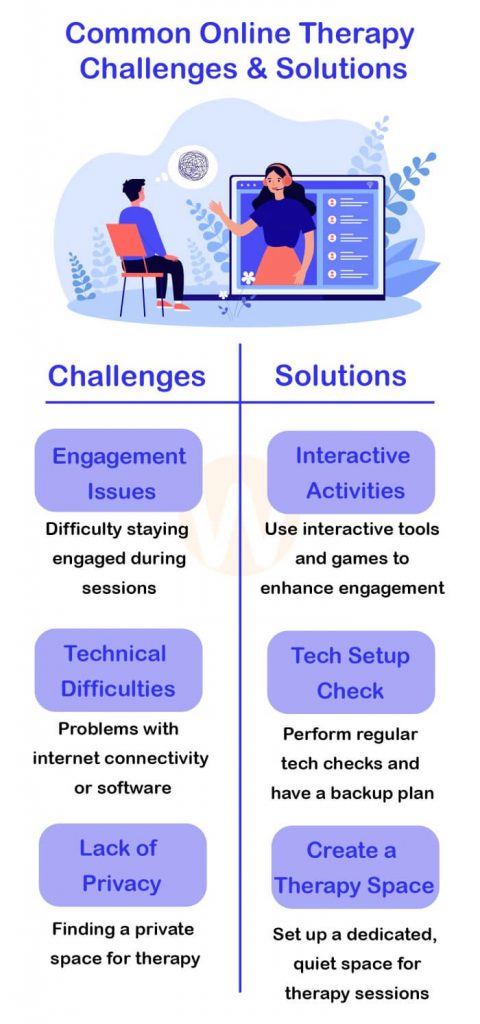Transitioning from In-Person to Online Therapy: A Guide for Families
By Rajini D
Last Updated: December 30, 2023
Understanding the Need for Change
In recent years, we’ve seen a significant shift in how families approach therapy, with many turning towards online options. This change isn’t just a trend; it’s a response to evolving needs and circumstances.
Why Online Therapy?
The reasons for this shift are as varied as the families themselves. Let’s explore a few:
- Convenience: Online therapy removes the need for travel, making it easier for busy families to fit sessions into their schedules. This convenience is especially beneficial for those living in remote areas or with limited transportation options.
- Accessibility: Online platforms provide access to a broader range of specialists. No matter where you live, you can find a therapist that fits your family’s unique needs.
- Global Events: Recent global events, such as the COVID-19 pandemic, have made in-person sessions challenging. Online therapy offers a safe, uninterrupted option during times when meeting face-to-face isn’t possible.

Benefits of Online Therapy
Online therapy isn’t just a workaround; it offers distinct advantages:
- Flexibility: Scheduling is often more flexible with online sessions, allowing for appointments outside of traditional hours.
- Resource Availability: Many online therapy platforms offer additional resources like apps, interactive exercises, and educational materials that can enhance the therapy experience.
- Continuity: Life’s unpredictable nature means families sometimes relocate or face other changes. Online therapy provides continuity, ensuring therapy can continue no matter where life takes you.
Comparative Table: In-Person vs. Online Therapy
| Aspect | In-Person Therapy | Online Therapy |
|---|---|---|
| Location | Therapist’s office | Any comfortable space |
| Flexibility | Fixed schedule | More flexible timings |
| Accessibility | Limited by location | Accessible from anywhere |
| Resources | Depends on therapist | Wide range of online tools |
Getting Ready for Online Therapy
Transitioning to online therapy can be a smooth and beneficial process with the right preparation. This section covers the essential steps to get your family ready for online therapy sessions.
Initial Planning
Before diving into online therapy, it’s important to assess your family’s specific needs. Here’s how you can start:
- Understand Your Goals: Clearly define what you want to achieve through therapy. This could range from managing specific behavioral issues to general emotional support.
- Choose the Right Therapist: Look for a therapist who not only specializes in your required area but also has experience in conducting online sessions.
- Involve Everyone: If the therapy is for a child, ensure that all family members are on board and understand their roles in supporting the process.
- Test Run: Consider having a trial session to familiarize yourself with the online format and address any initial concerns.
Checklist for Online Therapy Preparation
| Preparation Step | Details |
|---|---|
| Technical Set-Up | Ensure stable internet, test devices |
| Environment | Set up a quiet, private space |
| Materials | Gather any necessary materials like notebooks |
Managing Expectations
It’s crucial to understand how online therapy differs from in-person sessions:
- Interaction Style: Be prepared for a different kind of interaction. Non-verbal cues might be less noticeable.
- Technical Glitches: Occasionally, you might face technical issues. It’s part of the process and usually easily resolvable.
- Self-Management: Online therapy requires a bit more self-discipline, as you’re in your own environment.
Online Counseling for Elderly People – Geriatric Psychotherapy” for readers interested in therapy for older family members.
Technical Set-Up for Online Sessions

A successful online therapy session depends on having the right technology set-up:
- Stable Internet Connection: Ensure your internet is reliable to avoid disruptions during sessions.
- Device: A computer, tablet, or smartphone with a camera and microphone. Test these before the session.
- Software: Download any required software or apps in advance. Many therapists use platforms like Zoom, Skype, or specialized teletherapy applications.
Creating the Right Space
The environment where you conduct therapy sessions can significantly impact their effectiveness:
- Quiet and Private: Choose a space where you won’t be disturbed. Privacy is key for open communication.
- Comfortable Setting: Make sure the area is comfortable for the duration of the session – this could mean arranging cushions, chairs, or even lighting.
- Minimal Distractions: Remove distractions from the room, such as toys or loud clocks.
- Necessary Supplies: Have any materials suggested by your therapist ready, like notebooks or art supplies.
The Role of Families in Online Therapy
Embracing online therapy means recognizing the crucial role that families play in the process. Active family involvement can significantly enhance the therapy experience, especially in an online setting.

Increased Family Involvement
- Be Present: If the therapy is for a child, it’s helpful for a family member to be nearby during the session. This ensures the child feels supported and can assist in navigating any technical issues.
- Communication: Keep an open line of communication with the therapist. Share observations about your child’s progress or any concerns you might have.
- Collaboration: Work together with the therapist to set goals and strategies for the therapy. This collaboration ensures that therapy aligns with your family’s needs and values.
Practical Tips
Supporting your child during and after online therapy sessions can be done in several ways:
- Pre-Session Preparation: Help your child get ready for the session by ensuring they’re comfortable and the technology is set up correctly.
- Post-Session Discussion: Encourage your child to share their feelings about the session. It’s a good opportunity to discuss what they learned and how they felt about it.
- Reinforcing Therapy at Home: Implement any strategies or exercises suggested by the therapist in your daily routine to reinforce the therapy’s effectiveness.
Addressing Common Challenges
Online therapy, like any new venture, can come with its own set of challenges. Here’s how to address them:

Typical Issues Families Face
- Engagement Issues: Sometimes children may find it hard to engage with a therapist through a screen.
- Technical Difficulties: Issues like poor internet connection or software problems can disrupt sessions.
Finding Solutions
- Enhancing Engagement: Create a routine around therapy sessions to build consistency. Use interactive tools or games recommended by your therapist to keep the child engaged.
- Tech Troubleshooting: Have a backup plan for technical issues. This could be as simple as switching to a phone call if the video connection fails.
- Regular Practice: Encourage your child to practice the skills they learn in therapy outside of sessions. This helps in retaining and applying what they’ve learned.
“How to Build Emotional Connection and Maintain Positive Relationship with Children – Teen Parenting Tips” for more strategies on engaging children in therapy.
Tracking Progress in Online Therapy
Monitoring progress in online therapy is key to understanding its effectiveness and making necessary adjustments. Here’s how you can track the success of your or your child’s online therapy sessions.
Measuring Success
- Set Clear Goals: Start by setting specific, measurable goals with your therapist. This could range from improving communication skills to managing certain behaviors.
- Regular Assessments: Many online therapy platforms, including Wellness Hub, offer tools for tracking progress. These can be through regular assessments or progress-tracking features within the platform.
- Journaling: Encourage your child to keep a journal of their thoughts and feelings. Reviewing this over time can provide insights into their progress.
- Observable Changes: Pay attention to noticeable changes in behavior or mood in daily life, as these can be indicators of the therapy’s impact.
Feedback and Communication
Open and ongoing communication between the therapist, the child, and the family is crucial in online therapy.
- Regular Check-Ins: Schedule regular meetings with the therapist to discuss progress and any concerns.
- Feedback Mechanism: Utilize feedback tools provided by the online therapy platform. These could include surveys or direct messaging features.
Making the Most of Online Therapy
To ensure that online therapy is as effective as possible, engagement and proper use of resources are vital.
Staying Engaged
- Interactive Activities: Use interactive elements like games or storytelling in sessions to keep the child engaged.
- Routine: Establish a consistent routine around therapy sessions to create a sense of predictability and comfort.
- Incentives: Sometimes, small rewards for participating in sessions or completing therapy-related tasks can be motivating.
Using Online Resources
- Educational Materials: Many online therapy platforms offer additional materials like videos, articles, and exercises. Make use of these resources to supplement the therapy sessions.
- Wellness Hub Resources: On Wellness Hub, explore the range of available resources tailored to different needs, which can enhance the therapy experience.
- Interactive Exercises: Engage with interactive exercises or apps that are recommended by your therapist. These tools can make learning and development more enjoyable for your child.
“Online Adolescent Counselling” and “Online Counseling for Workplace Stress – Occupational Stress” for readers seeking additional resources on managing stress and adolescent issues through online therapy.
Real Stories: Successful Online Therapy Transitions
Hearing about the experiences of other families can be incredibly inspiring and educational. Here, we share a couple of success stories from families who made the transition to online therapy smoothly, emphasizing the positive outcomes they achieved.
Family Experiences
- The Kumar Family: The Kumars were initially hesitant about switching to online therapy for their son, Arjun. However, after a few sessions, they noticed a significant improvement in Arjun’s communication skills. They credited the easy-to-use interface of online platforms and the engaging activities provided by the therapist for keeping Arjun interested and participative.
- The Garcia Family: Maria Garcia, a single mother, found online therapy to be a lifesaver. Her daughter, Elena, needed consistent therapy sessions, which became challenging due to Maria’s work schedule. Online therapy offered the flexibility they needed, and Elena could continue her sessions without any disruption.
Key Learnings
From these stories, several key learnings emerge:
- Flexibility and Convenience: Online therapy provides flexibility, which is especially beneficial for busy families or those with logistical challenges.
- Engagement is Key: Interactive and engaging sessions can significantly enhance the effectiveness of online therapy for children.
- Openness to New Experiences: Being open and adaptable to the new format of therapy can lead to surprising and positive results.
Wrapping Up
Summary
In summary, transitioning to online therapy can be a highly effective and convenient option for many families. By setting clear goals, preparing adequately, staying engaged, and using the right resources, families can make the most out of online therapy sessions. Remember, active family involvement and open communication with the therapist are crucial for success.
Encouragement and Support
We understand that change can be daunting, but with the right approach and mindset, transitioning to online therapy can be a smooth and positive experience for your family. At Wellness Hub, we are committed to supporting you every step of the way. Whether it’s through providing resources, offering flexible scheduling, or sharing success stories for inspiration, we are here to help you and your family thrive in the online therapy journey.
“How to overcome test anxiety” or “What are some test-taking strategies for students?” for those seeking specific advice on managing anxiety or educational challenges.
Frequently Asked Questions (FAQs) for “Transitioning from In-Person to Online Therapy”
1. What are the main benefits of transitioning to online therapy?
The primary benefits include convenience, flexibility, accessibility to a broader range of therapists, and the ability to continue therapy during global events like pandemics. Online therapy can also provide additional resources and tools not always available in traditional settings.
2. How can I tell if online therapy is right for my family?
Consider your family’s specific needs, such as scheduling flexibility, the type of therapy required, and how comfortable you are with using technology. Online therapy can be an excellent option for those seeking a convenient and adaptable form of therapy.
3. What technology do I need for online therapy?
The basic requirements are a stable internet connection, a device with a camera and microphone (like a computer, tablet, or smartphone), and any necessary software or apps recommended by your therapist.
4. How can we create a good environment for online therapy at home?
Choose a quiet, private space where you won’t be disturbed. Ensure it’s comfortable and free from distractions. Having any suggested materials, like notebooks or art supplies, can also be helpful.
5. How does Wellness Hub support families in transitioning to online therapy?
Wellness Hub offers personalized plans for each family, training and resources to get comfortable with the online format, and continuous support for any challenges you might face. We also provide a range of interactive tools and educational materials to enhance the therapy experience.
6. What role does the family play in online therapy?
Family involvement is crucial in online therapy. It includes being present during sessions, reinforcing learned skills at home, and maintaining regular communication with the therapist.
7. How do we address common challenges like engagement issues in online therapy?
Enhancing engagement can be achieved by creating a routine around therapy sessions, using interactive tools or games, and having a backup plan for technical issues. Regular practice of the skills learned in therapy also helps in maintaining engagement.
8. How is progress tracked in online therapy?
Progress can be monitored through regular assessments, feedback mechanisms provided by the therapy platform, journaling, and observing noticeable changes in daily behavior or mood.
9. Are there any success stories of families who have transitioned to online therapy?
Yes, many families have successfully transitioned to online therapy. Their experiences often highlight the importance of flexibility, engagement, and openness to new experiences.
10. Can online therapy be as effective as in-person therapy?
Yes, for many individuals and families, online therapy can be as effective as in-person therapy. It depends on the specific needs of the family, the nature of the therapy, and how well the family and therapist adapt to the online format.
About the Author:
Rajini, Speech-Language Pathologist:
Rajini is a dedicated Speech-Language Pathologist with a focus on developmental speech and language disorders in children and rehabilitation in adults. With a passion for helping each individual find their voice, Rajini brings a wealth of experience and a heartfelt approach to therapy. At Wellness Hub, she’s part of a team that values innovation, compassion, and results-driven practices.
Book your Free Consultation Today
Parent/Caregiver Info:
Client’s Details:
* Error Message









